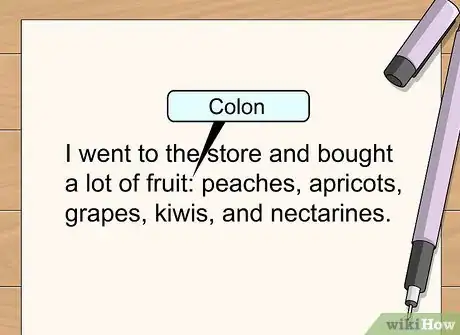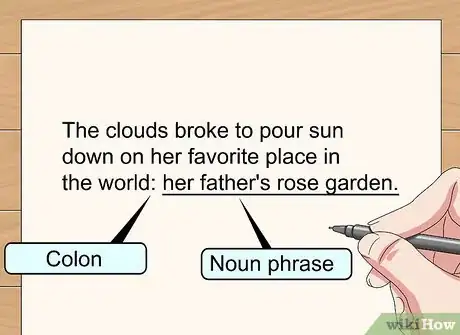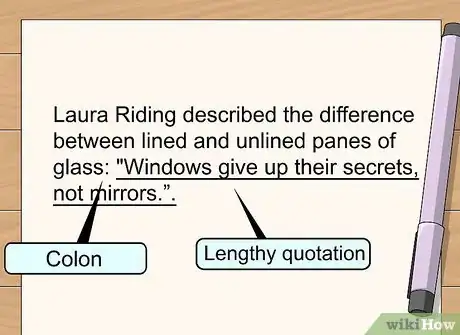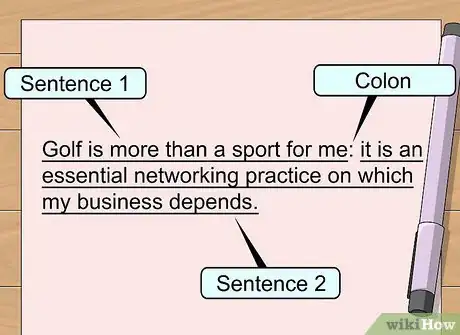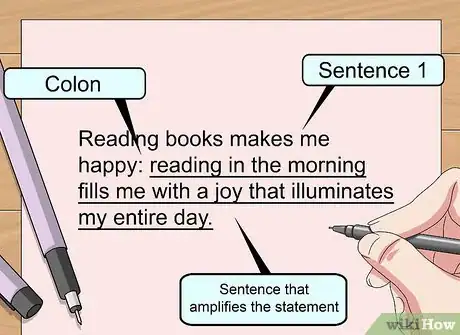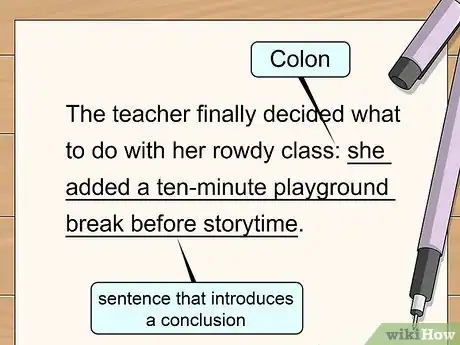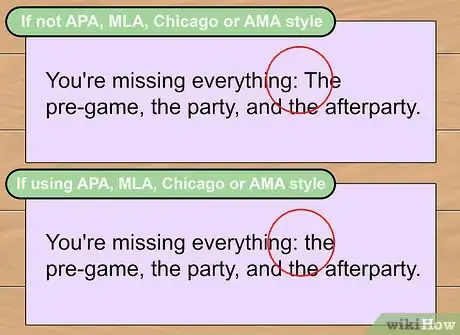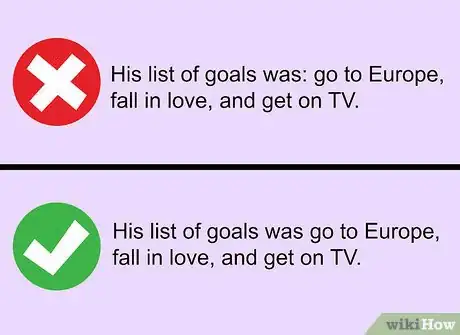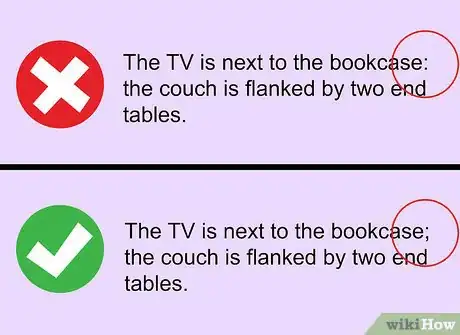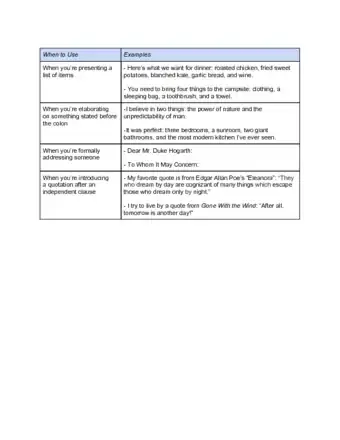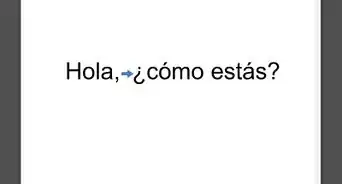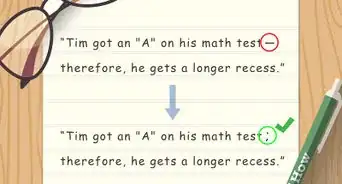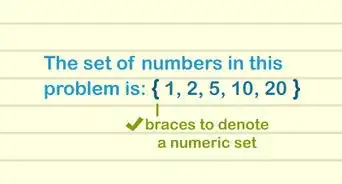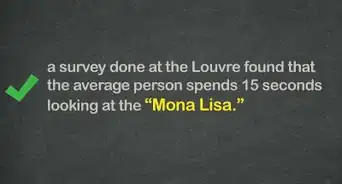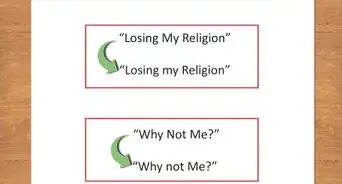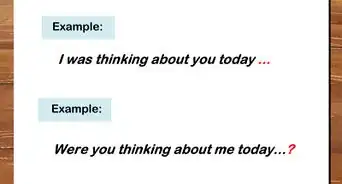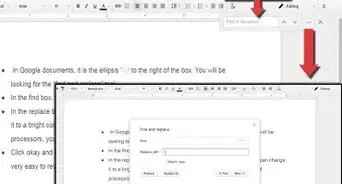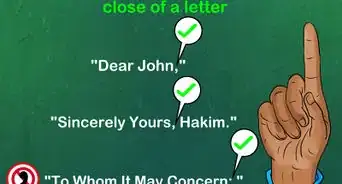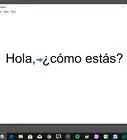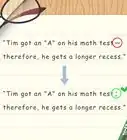This article was co-authored by Tristen Bonacci. Tristen Bonacci is a Licensed English Teacher with more than 20 years of experience. Tristen has taught in both the United States and overseas. She specializes in teaching in a secondary education environment and sharing wisdom with others, no matter the environment. Tristen holds a BA in English Literature from The University of Colorado and an MEd from The University of Phoenix.
There are 7 references cited in this article, which can be found at the bottom of the page.
wikiHow marks an article as reader-approved once it receives enough positive feedback. In this case, 100% of readers who voted found the article helpful, earning it our reader-approved status.
This article has been viewed 730,057 times.
Colons are like flashing arrows: they are there to direct your attention to the information that follows them. Colons are used to connect sentences, to present information, and to set off lists and quotations. They call your attention to information following an independent clause, and that information amplifies, explains, or fulfills the information presented before the colon. Once you know how to use a colon, it's easy to remember.
Steps
Using Colons to Direct Attention
-
1Precede a list with a colon. Connect a full sentence with a list using a colon. The colon sets off your information, making it easy to sort. Consider these examples:[1]
- "I went to the store and bought a lot of fruit: peaches, apricots, grapes, kiwis, and nectarines.
- "You're missing everything: the pre-game, the party, and the afterparty."
-
2Set off a noun or noun phrase with a colon. Colons can be used to join a full sentence with an explanatory noun, proper noun, or noun phrase. Use this to place a lot of emphasis on the noun.[2]
- You can write, "My nightmare revealed to me my deepest fear: solitude."
- Another example could be, "The clouds broke to pour sun down on her favorite place in the world: her father's rose garden."
Advertisement -
3Introduce a lengthy quotation. To quote a full sentence or more, lead with a colon.[3] Don't do this if you are only quoting a few words. Proper usage might include any of the following:[4]
- 'In her poem "Houses," Laura Riding described the difference between lined and unlined panes of glass: "Windows give up their secrets, not mirrors."'
Connecting Full Sentences with Colons
-
1Join a sentence with another that explains it. Colons can be used to connect full sentences that are related. When the second sentence serves to explain the first, they can be connected with a colon. Here are some examples:[5]
- "Golf is more than a sport for me: it is an essential networking practice on which my business depends."
- "I gave him my number: I wanted to see him again."
-
2Amplify a statement. Connect two full sentences with a colon if the second sentence serves to extend, or amplify, the first.[6]
- For instance, you could write, "Reading books makes me happy: reading in the morning fills me with a joy that illuminates my entire day."
-
3Introduce a conclusion. Connect a sentence that introduces a problem with another sentence that provides the conclusion.[7] A colon may also imply that the second sentence is the result of the first.[8]
- For instance, you could say, "The teacher finally decided what to do with her rowdy class: she added a ten-minute playground break before storytime."
- An example of an implied connection might be, "We brought too much bread to the picnic: the birds were very happy."
Avoiding Common Colon Mistakes
-
1Capitalize after the colon in certain cases. When you use a colon to connect two full sentences, you can capitalize the first letter of the second sentence or not. If you are writing a paper in a certain style, such as APA, MLA, Chicago, or AMA, you must follow their guidelines.[9]
- Do not capitalize the first letter of the second clause if it is not a complete sentence.
- Do not capitalize the first letter of the second clause if you are writing a paper using MLA or AMA formatting, unless it is a proper noun.
- Do capitalize the first letter of the second clause when using APA formatting.
- When using Chicago formatting, capitalize the first letter after a colon only if it introduces two or more sentences. Example: "Masha had three options: She could cry. She could yell. Finally, she could pretend that nothing had happened."[10]
-
2Do not use a colon after an incomplete sentence. A common colon error is to use the colon to introduce a list of nouns after an incomplete sentence. Sentences that include common mistakes sound abrupt and disjointed:[11]
- "His list of goals was: go to Europe, fall in love, and get on TV."
-
3Use colons only to connect related sentences. Complete sentences that do not have a clear causal or thematic connection should not be connected with colons.[12]
- It would be incorrect, for instance, to write this: "I would have to go to the store in an hour: winter in Minnesota is cold."
- A correct usage might be, "I would have to pick up a solid coat: winter in Minnesota is cold."
-
4Don't use a colon where a semi-colon should be. When you are connecting two full sentences that are of equal weight, a semi-colon will serve you better than a colon. A colon draws attention to the clause that follows it, while the semi-colon does not.[13]
- For instance, it would be incorrect to say, "The TV is next to the bookcase: the couch is flanked by two end tables." This is because the second clause does not explain, amplify, or answer the first. It merely adds more information.
- Instead, you would write, "The TV is next to the bookcase; the couch is flanked by two end tables."
Colon Usage Cheat Sheet
Community Q&A
-
QuestionIs it correct to write a sentence like this: "Remember: if you don't listen carefully, you won't know what steps to follow."
 Community AnswerYes.
Community AnswerYes. -
QuestionCan I use a colon twice in a sentence after two or three words?
 DonaganTop AnswererIt would be an extremely unusual--even awkward--sentence if it required two colons.
DonaganTop AnswererIt would be an extremely unusual--even awkward--sentence if it required two colons. -
QuestionIs this correct? "Give me: cheese, bread and butter."
 DonaganTop AnswererNo colon needed.
DonaganTop AnswererNo colon needed.
References
- ↑ https://wmich.edu/writing/punctuation/colon
- ↑ Tristen Bonacci. Licensed English Teacher. Expert Interview. 21 December 2021.
- ↑ Tristen Bonacci. Licensed English Teacher. Expert Interview. 21 December 2021.
- ↑ https://www.grammarly.com/blog/colon-2/
- ↑ http://writingcenter.unc.edu/tips-and-tools/semi-colons-colons-and-dashes/
- ↑ http://writingcenter.unc.edu/tips-and-tools/semi-colons-colons-and-dashes/
- ↑ Tristen Bonacci. Licensed English Teacher. Expert Interview. 21 December 2021.
- ↑ http://writingcenter.unc.edu/tips-and-tools/semi-colons-colons-and-dashes/
- ↑ https://wmich.edu/writing/punctuation/colon
- ↑ http://archives.cjr.org/language_corner/how_to_use_the_colon.php
- ↑ https://new.sewanee.edu/academics/writing-center/resources-for-students/handouts-and-writing-resources/dashes-colons-and-semicolons/
- ↑ https://new.sewanee.edu/academics/writing-center/resources-for-students/handouts-and-writing-resources/dashes-colons-and-semicolons/
- ↑ https://examples.yourdictionary.com/examples-of-colons-and-semicolons-in-sentences.html
About This Article
The most common way to use a colon in a sentence is to introduce a list with it. But you can also use a colon to introduce a quotation or to join a sentence with one that explains it. For example, the following quote is two sentences, where the second explains the first: “I gave him my number: I wanted to see him again.” Structures like that can emphasize the second sentence as well, if they are well written. Keep reading to learn more ways to use colons in sentences!
